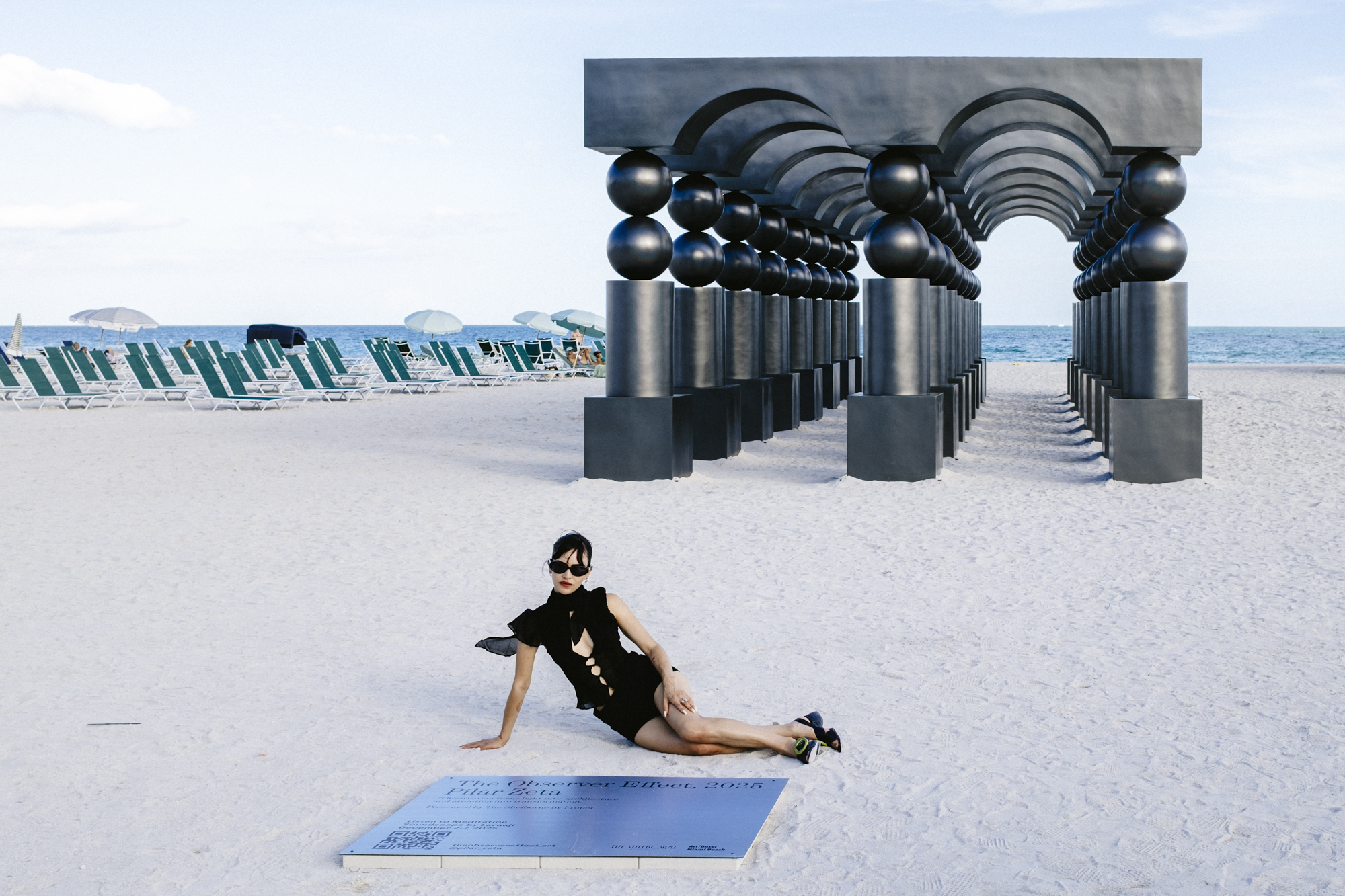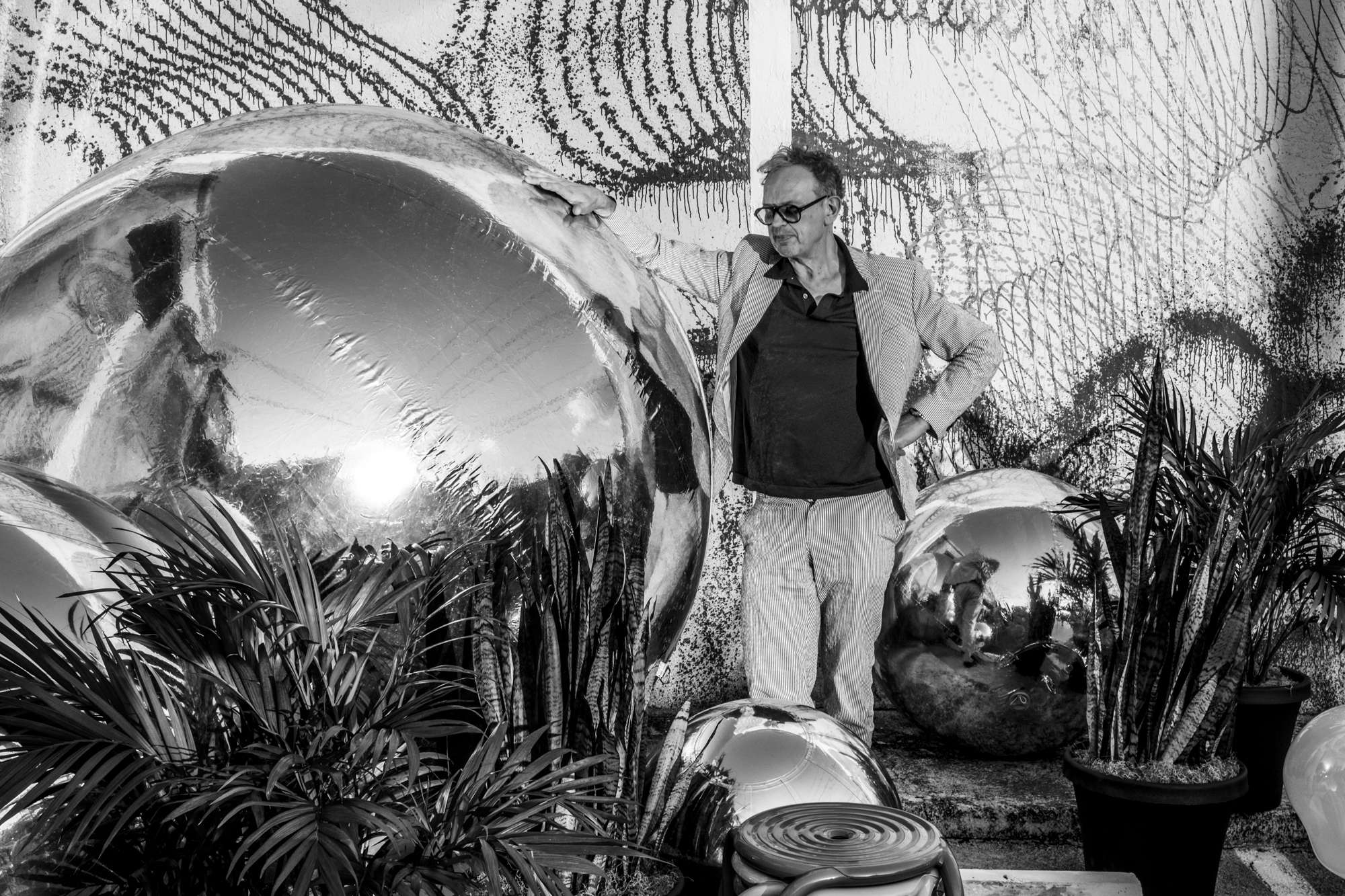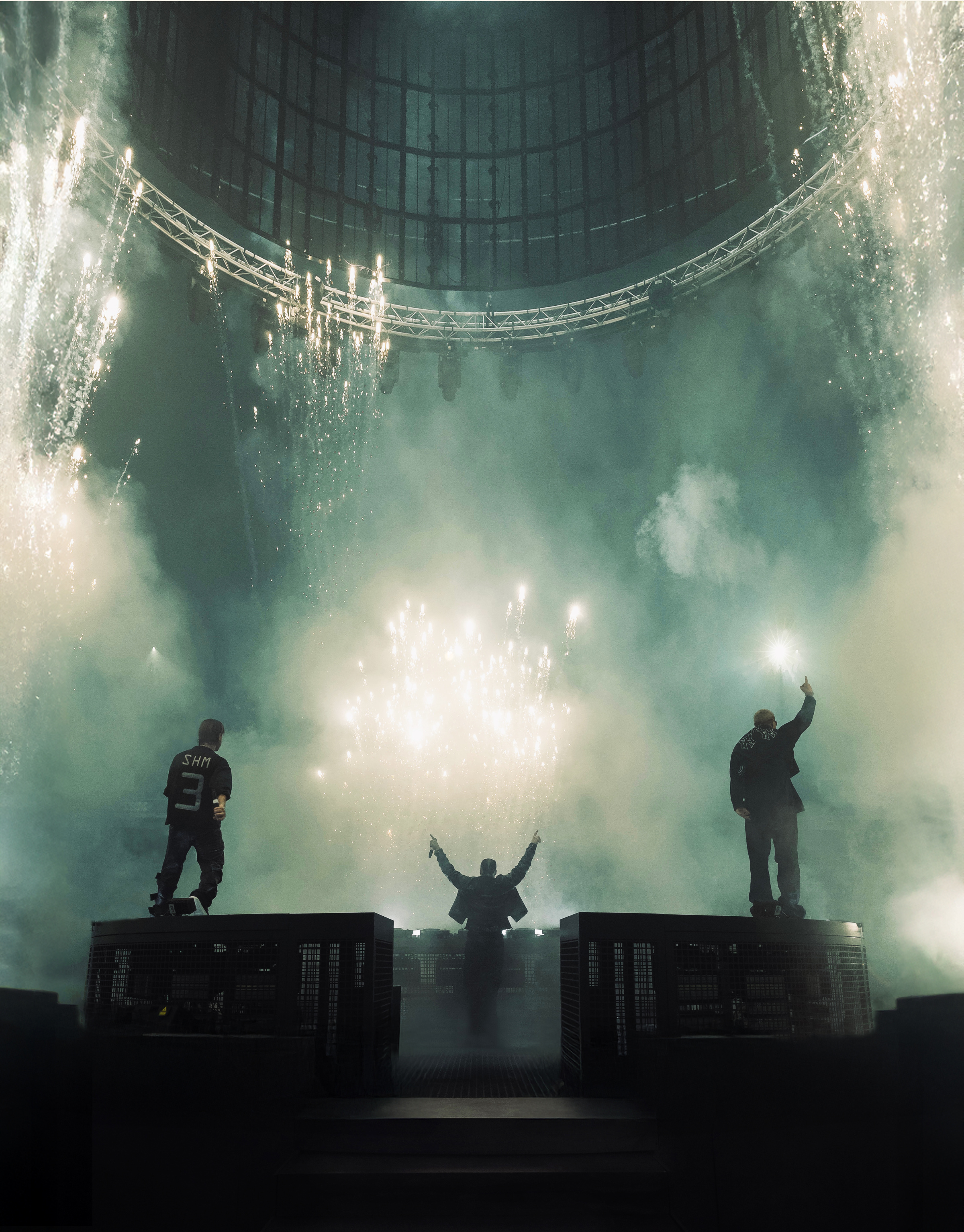Studio Goons creates the type of work that makes you crave novelty. Founded in 2020 by architect Paul Trussler and creative editor Mia Kim, the Paris-based atelier is all about taking a simple-yet-unpredictable artisanal approach. As we chat about their career, their upcoming solo exhibition, and a bench they panic-crafted in three hours prior to hosting a dinner party—that definition feels spot-on. The duo tells me Goons’ work is meant to live, breathe, and evolve with the ever-changing demands of life.
Paul’s architectural portfolio spans an impressive range of museums, galleries, homes, and restaurants across the globe. Once an architectural protégé of Frank Gehry, he’s all about handcrafted objects, intricate model-making, detailed drawings. Mia brings a multidisciplinary background in fashion, painting, and sculpture to the Goons table. Having worked with Parisian fashion houses including Hermès and Chanel, her creative edge shows in everything Goons designs.
I sat down to chat with Paul and Mia just before the opening of their debut solo exhibition, “Evolving Forms,” at St. Vincents Gallery in Antwerp, Belgium.

For Studio Goons, longevity is also the at the center of design. “No matter how much sustainability you pretend to have, if you’re designing for short-term trends, you’re not going in the right direction,” Paul says.
How does your practice celebrate unpredictable design? What led you to wanting to hone that?
Paul Trussler: I think it’s unpredictable in the way that it isn’t defined by what scope we’re going to take. Because of our background, we have a pretty diverse set of skills—from Mia’s painting and sculpture to design and fashion design, and then beyond that as well, and me in architecture.
I come from a specific type of architecture where there was an emphasis on hand-making models for very large cultural projects. When we say unpredictable, we’re not really set on what type of “scope” we’re going to take on. Projects could come along and we’re not deciding “yes” or “no” based on some predetermined scope that we have. It’s unpredictable in that way.
In terms of how we do our designs or how we make our projects, it’s quite predictable. We really established from the very beginning this set of principles of how we work, how we design, what materials we use, which processes we use, and which languages we’re using.
Some of it is explainable and some of it is just about the collaboration between Mia and I. We both have an eye for what we like. I think “dumb design” is kind of a funny way to say it. But our practice is about taking a really simplistic design path. If something is overly complicated, we don’t do it. We always try to find the perfect, economic way.
- The use of zig-zag motifs in Studio Goons’ work traces back to the studio’s early days, seen here in the Totem side table. “Mia created an Instagram account for us and posted a photo of some pieces I made from shipping crates featuring the zig-zag design,” Paul recalls. “A Parisian gallery—who we still work with—messaged us, purchased a piece in cash, and has represented us ever since.
- “Some of these pieces are super original and have had a more ‘mythical’ background than others. The Standard console table (left) and Original stool (right) here are two very good examples of that. The stool was the very first piece Goons ever made. We’ve made many more since, but that is that precious first one,” Paul says.
Mia Kim: Our practice is unpredictable in the sense that we are really relying on our instinct and our experiences, and we just go with that. We don’t plan out those things. But we definitely have a philosophy that’s solid and a language that is very defined. Because of that structure, we’re allowed to be more free-styled about it. That’s why we call it “unpredictable” in a sense.
Paul: That really caps it off. Day to day it is a bit unpredictable and predictable. We’ll look at things or problems around us—we just moved to a new apartment, for example. And this isn’t related to the studio’s normal work. But we’re looking at creating shelving options or new bookshelves, coffee tables—things that are not in the Goon’s catalog but that we need for our apartment.
We both can say, “Oh yeah, that’s kind of the Goon’s way.” Like, we would know this is how Goons would do shelves. We can tackle these unpredictable problems in a very predictable, easy way.
Another part of the process was understanding the differences between fashion and architecture: fashion is extremely fast, while architecture is incredibly slow. Architecture projects take five, six years, whereas fashion projects can be completed in a year or less. We wanted to land somewhere in between. One of our guiding principles became: we won’t get caught in emergency situations. We won’t take on projects that drag on for years. This helped us establish a working philosophy focused on scale, efficiency, and time.

“Our approach is super non-abrasive,” owners Paul and Mia say. “Trust your eye, trust the approach, don’t make it too complicated, and you’ll see what beautiful things can come out of it. We don’t say ‘yes’ to everything either. We trust our instincts and we know when something is working or not.”
When you’re working on a new project or piece, what does the process look like? Is it a case of figuring out how you can simplify things, or even putting certain ideas on the chopping block to make things more efficient and enjoyable?
Mia: Generally there’s a lot of joy in every day of our work, whether it’s designing new pieces or creating custom pieces for clients. The workflow between us is highly collaborative. We quickly align on the direction, often through hand sketches, some quick 3D models, or samples. We start with various ideas—sometimes sketches in a notebook, sometimes on a screen.
Occasionally we’ll even build small models. It all depends on the project and the initial information we have.
If it’s a custom piece, we start with whatever information the client provides, and that can affect the direction we take. But the most important part is the design itself. At the beginning of the process, we put a lot of effort into making sure we’re creating the most beautiful solution possible. That’s our main focus. Because of how we work, the design process can be incredibly fast—sometimes it takes just a few hours and we’re ready to move forward. But we always ask ourselves if it’s “Goons.” Is it really right? Is this the best version of it? If it’s not, we’re okay with starting from scratch. Refining the design as we go is also a big part of the process, and that’s the enjoyable part.
- Studio Goons approaches sustainability holistically when designing their collections. “We’ve selected a material where every small piece is considered valuable,” Paul explains. “We put significant effort into ensuring we don’t generate waste.” Above: Brace chair
- “Our biggest conversations are always about the longevity of design. That was a big conversation before we even started the studio. We talked a lot about how fast-fashion was growing and how it was important for us to create objects that are built to last.” From left: A prototype shelf, Form stool, Flat Pack chair, Form Entry Table, and Lounge Chair 01 – Wenge
Paul: Once we’re at the production stage, things start to get more serious. We build 3D models that are really accurate, and we also work on the physical version of the design. Questions will come up, like, “How should we adjust this joint?” or “Should this be a little narrower or wider?” We’ll work in the studio together to figure out those details.
It’s not like we just design something in an hour and call it done. There’s a lot of back-and-forth, especially when it comes to the prototype stage. For example, just this week we were testing out the first prototype for a new project. We sat down and evaluated the angles, the softness of the piece, and the overall proportions. It’s a lot of fun but also a critical part of the process.
It’s great that you have a clear Goons “metric” that helps you stay efficient, but also ensures you’re creating something that feels right. It seems like that question has become an important part of your process.
Mia: It’s actually something that came about naturally though it wasn’t our initial intention when we started the studio. But now that we have it, it really helps with efficiency. We both know what Goons means, and that shared understanding helps us move faster. It’s one of those things that’s hard to explain, but it just works. It feels so natural and instinctive.
- “The M console table design was actually an accident,” Mia says. “Paul had a lot of pre-cut wood laying around in the studio. I walked in to get something and saw the way he stacked some of the wood. I thought it looked really great! I took photos of it and we ended up developing it.”
- “The Form stool was born out of a doodle session,” Mia says. “We started with placing different shapes on top and then doodled around it. Paul has as thing for stools with lots of chunky legs. It was something he started doing when he worked with Frank Gehry.”
Beyond just your work, your personal lives also deeply influence your designs. You’re also raising a young family. How does that fit into the work?
Mia: There’s definitely a flexibility in how we approach things. Our lives evolve and we expect our designs to evolve with us. We make pieces that are meant to last a long time, and we want them to be adaptable. When we look at the pieces we’ve created for ourselves, we see how they’ve been used in different stages of our lives. That’s an important consideration in everything we design. It’s not just about what we need now, but how it will fit into our lives down the road. It’s something we both naturally think about.
Paul: We’ve been working together for a long time, and we’ve seen how our designs have adapted over the years. That’s something we want to build into the work we do for others too. The pieces we create should respond to changing needs and situations. The longevity and adaptability of a piece are key.
Mia: We’ve also learned from the most influential jobs we’ve had, which were in luxury fashion and architecture. These industries are focused on creating things that last—things that are cultural institutions and passed down through generations. That mindset has really shaped how we think about design. Whether it’s high-end fashion or architecture, the pieces we create need to stand the test of time.
- “The black chair here is called the Art Rocker. A lot of people love this design, but no one has ever bought one!,” Paul says. “It’s a bit weird, and I’ve only ever made one, but it’s one of our favorite things. It’s based on a sculpture by Richard Artschwager. He did this series of platonic furniture that was reduced down to its most basic shape. We just liked that idea a lot.”
- “Most people who do this kind of work use a veneer piece to cover the exposed sides of the wood that have extra detailing,” Paul says. “That’s stupid. We make a point to keep it unhidden because it’s so much more visually honest.” From left: Original stool, Foundation console
Paul, I know you worked for Frank Gehry in Los Angeles, and that must have had a big impact on how you approach architecture and design. Similarly with Mia in luxury fashion design. Could you tell me more about that?
Paul: Definitely! I worked for Frank Gehry for about seven years, and the projects there were extremely high-end. We worked on museums, restaurants, artists’ homes, and other cultural buildings. It was all about designing for longevity, creating pieces that would last for generations.
After that I moved to Paris and worked with a younger Japanese architect for about five years. It was similar in that we focused on cultural buildings, high-end restaurants, and other prestigious projects. The design philosophy was rooted in creating something that would stand the test of time. That’s something that’s deeply ingrained in my approach.
Mia: My experience in fashion design was also very much about luxury and longevity. I worked for brands like Hermès and Chanel, where the focus was always on creating timeless pieces. It’s all about making things that have value beyond the moment, that can be passed down and appreciated for years to come. Everything we make is built to last.

“Because of how we work, the design process can be incredibly fast—sometimes it takes just a few hours and we’re ready to move forward. But we always ask ourselves if it’s ‘Goons.’ Is it really right? Is this the best version of it? If it’s not, we’re okay with starting from scratch. Refining the design as we go is also a big part of the process, and that’s the enjoyable part.” Above: Brace chair, AC, and stool, and Five-Points console and table
It sounds like it was a big part of shaping your professional mindset. How did those two paths eventually cross and end up creating Goons?
Mia: We met in Capri, Italy, actually, at a wedding. It was totally unrelated to work! My high school friend who Paul grew up with invited us both. Paul was living in LA at the time and I was already in Paris. So, it wasn’t a work connection at all.
We clicked right away. We had a lot of shared interests, especially when it came to design. Even though we weren’t thinking about it at the time, we knew from the start that we could build something together. And later that led to the studio.
Paul: It was clear from the beginning that we shared a lot of the same values, both personally and professionally. That mutual understanding made it easy to transition into working together.
I hear there’s a story about a bench you two made together in three hours during those early days! How did that come about?
Mia: That’s one of our favorite stories! So at the time we were just starting our studio. I was still working at Chanel and Paul at the architecture office. We had just moved into a new apartment, and we didn’t have enough seating for a gathering we were hosting. We needed a bench so we thought, “Why not just make it ourselves?” We’d been discussing the Goons concept at that point so I had set a challenge: I was giving us three hours to make a bench, and it had to be done in time for our guests to sit on it that night. No exceptions.
- The tall Entry column on the right came to be during a photoshoot in the Goons studio. “We had random pieces of wood lying around, and Mia just kind of stacked them and put a piece on top as a component of the photoshoot. Afterward we were like, ‘we have to make this’ and glued it together exactly as she posed it.” Back left: Truss console. Front: Freeplan bench
Paul: The idea was to create something within a strict constraint so we couldn’t afford to get bogged down in design revisions or delays. I ended up making the bench after hours at the architecture office—I didn’t want anyone to know I was working on personal projects in the workshop. It was the perfect experiment. We made sure the whole thing, from building to painting, within the three hours. I think Mia finished painting it in the last half hour, and that was that!
Mia: It was a fun challenge. That kind of time pressure forced us to make quick decisions and avoid overthinking, which really shaped our approach. Even now we still remember that exercise. Sometimes we’ll work under similar constraints, though we take a little more time now since we’re making pieces that people are actually buying.
It’s about finding the simplest, most direct solution. It’s funny how that challenge has influenced the way we work now. We approach things with that same mindset: if it’s hard, we change it, and if it doesn’t work, we stop and try something else.












